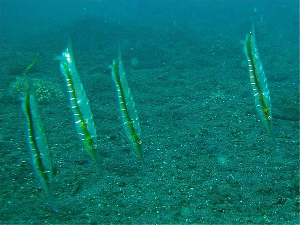Snipefishes, shrimpfishes, razorfishes & bellowfishes
The closely related Centriscidae also have flattened bodies. They often orient vertically in the water column, mimicking coral or seagrasses, for camouflage from predators and prey alike. The Centriscidae are present around the world in tropical and subtropical waters.
Centriscidae (Snipefishes, Shrimpfishes, Razorfishes & Bellowfishes)
| Photo | Scientific Name | Common Name(s) | IUCN Red List Status | Profile | Range |
 |
Aeoliscus punctulatus
(Bianconi, 1854) |
Shrimpfish, speckled shrimpfish |
DD | Western Indian Ocean | |
 |
A. strigatus
(Günther, 1861) |
Razorfish | DD | Indo-Pacific | |
 |
Centriscops humerosus
(Richardson, 1846) |
Banded bellowsfish, banded snipefish |
LC | Circumglobal in s. temperate oceans | |
 |
Centriscus cristatus
(De Vis, 1885) |
Smooth razorfish | DD | Indo-Pacific | |
 |
C. scutatus
Linnaeus, 1758 |
Grooved razorfish, grooved shrimpfish, rigid shrimpfish, serrate razorfish, | LC | |
Central & Eastern Indian Ocean, Indo-Pacific |
 |
Notopogon armatus
(Sauvage, 1879) |
LC | Western Indian Ocean | ||
 |
N. fernandezianus
(Delfin, 1899) |
Orange bellowfish | LC | Southeastern Pacific, south-western Atlantic | |
 |
N. lilliei
Regan, 1914 |
Crested bellowfish, bristle snipefish |
LC | Australia & New Zealand, southwestern Indian Ocean, southeastern Atlantic | |
 |
N. macrosolen
Barnard, 1925 |
Longspine bellowsfish, longsnout bellowfish | LC | Southeastern Atlantic | |
 |
N. xenosoma
Regan, 1914 |
Longspine bellowsfish, orange bellowsfish |
LC | Southern Indian Ocean, Australia & New Zealand |
| Photo | Scientific Name | Common Name | IUCN Red List Status | Profile | Range |
 |
Macroramphosus scolopax
(Linneaus, 1758) |
Longspine snipefish | LC | Atlantic, Indo-Pacific |
IUCN RED LIST KEY
EX = Extinct
EW = Extinct in the Wild
CR = Critically Endangered
EN = Endangered
VU = Vulnerable
NT = Near Threatened
LC = Least Concern
DD = Data Deficient
NE = Not Evaluated
(Click here for a full explanation of IUCN Red List categories.)
A note on ‘Data Deficient’ species: Species that are assessed as ‘Data Deficient’ are deemed to have insufficient information known about them to carry out a proper conservation assessment. Although such species are not assessed as threatened, we may find out that they in fact are, once enough data is obtained.
[Updated Jan 2016]

